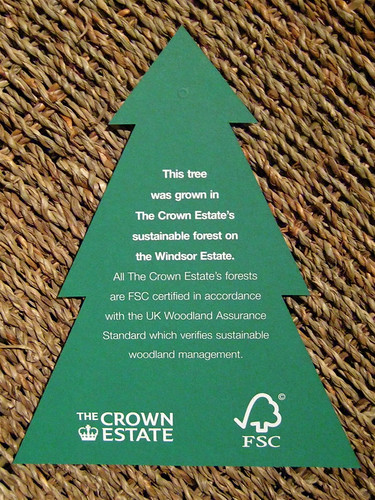With GreenBuild a mere six days away, I'm excited and hopeful for the new improvements and announcements that few days will bring. In some ways it's like LEED Christmas, and I've decided it might be fun to write a letter to Santa! I started writing this and determined I wish for too much for one post, so I've been forced to split my into many parts, so there's more to come. I've been good this year, so I'm hoping for at least a few of my wishes to come true by the new year!
See Part 1 of this installment - LEED-Online Wishlist.

Make sure your Christmas Tree is FSC Certified... SFI certified trees do NOT contribute towards a Merry Christmas!
Part 2 - Reference Materials
No one can argue that the USGBC is a powerhouse when it comes to marketing sustainable design and LEED in particular. They create excellent presentations that are graphically clear and the content is concise. They compile advocacy campaigns that include presidents, almost presidents, and a whole bunch of mayors for good measure!
Given such impressive informative efforts, why should we as LEED AP's have to struggle through three sets of CIRs (see below) to find one answer? This brings me to the second installment of my Greenbuild wishlist, which focuses on reference materials I wish we had, and changes I'd like to see to things that already exist:
- Please send me a revised "LEED-NC Application Guide for Multiple Buildings and On-Campus Building Projects" that offers more than 1/2 a paragraph worth of guidance for each credit. Really I'd just like clearer guidance about how to set project boundaries, especially for projects in multiple phases.
- RealLife LEED would love an updated list that shows the likelyhood of attaining a credit based on the percentage of projects that have achieved it in the past. This is super helpful when you don't have a lot of project information but the client wants a checklist anyway. There was a file out there showing about 150 LEED-NCv2.0 and v2.1 projects and the points they achieved, but from what I can tell even that has been removed from the website.
- The USGBC needs to create a one stop shop for purchasing referenced standards. In the past, there were even standards that were impossible to buy in the US! (I'm speaking of the Carbon Trust Good Practice Guide 237, which may or may not be available at the link provided?) Tracking down these often obscure standards can be difficult to say the least. I'd be willing to pay a small premium even for the convenience.
- An RSS feed or email subscription to LEED technical updates would be immensely helpful. When the USGBC issues a PIECAP about changes to LEED-Schools VOC requirements, there should be a way to automatically get an email about it. The "USGBC Update" emails have a very helpful section on "LEED Updates" on the side, but really I just want to know about those!
- Combined CIRs! There is no reason I should have to sift through the CIRs for LEED-NCv2.0, then LEED-NCv2.1, then LEED-NCv2.2, then LEED-CS, then LEED-CI just to find an answer about recycled content or something similar. Browsing the CIR's should be by credit and not by rating system, even if there are slight differences in the structure of the credits.
- Free LEED AP educational materials! If the stated goal of the USGBC is market transformation then the best way to transform is to inform. The USGBC should be making it as easy as possible to study for and learn about the LEED process. Online LEED-AP courses ($150), the reference guides (at least $125), and even the exam ($300-400) should be completely free of charge to those wishing to learn more about sustainable design and LEED. Lost income could be made up by charging more for membership or actual certification.
- Bring back the excel based credit checklists!
- Provide complete sample project documentation for each rating system. Though some documentation is starting to appear on the net (see here and here), example projects from the USGBC for each rating system would still be immensely helpful.
Well, that's all that comes to mind right now, but I'm sure you have a few things you'd like to see or to switch around. Please share your thoughts on the subject by leaving a comment!
NOTE: Items 7 and 8 were posted a day after the original publication of this article, as I thought of a few more before I went to sleep!





2 comments:
Agree completely! Thanks for your great insight regarding LEED and the USGBC. I use your site almost daily to keep updated. It is an invaluable resource.
Macko
"In some ways it's like LEED Christmas"
Post a Comment